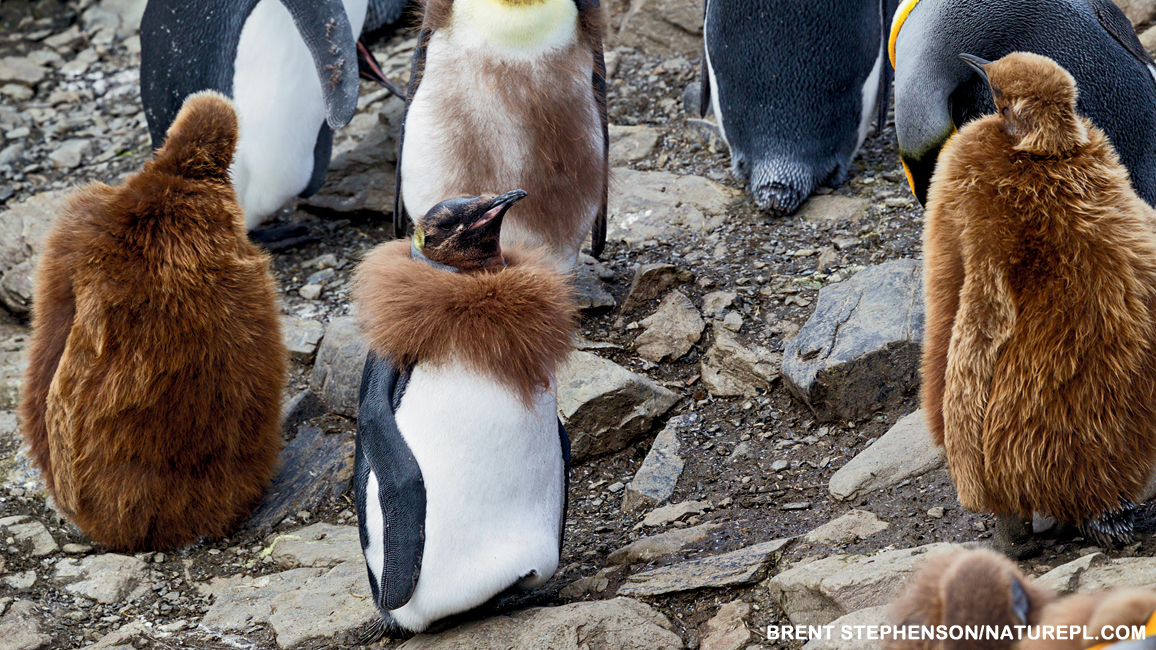
Losing It
By Kate HofmannFur, feathers, skin, or scales—after a while, they all get old or tight or not quite right. Then it’s time to lose them!

Do you wear different clothes in the heat of summer than you do in chilly wintertime? Many mammals change their fur coats with the changing seasons, too. If you have a pet dog or cat, you might sum it up this way: hair everywhere!
The reindeer in the photo above lives in the frigid Arctic and has one of the warmest winter coats around. When spring comes, the reindeer must shed that thick coat to keep from getting too hot.
Birds also change their “clothes” in different seasons. Some grow extra feathers to keep warm in winter. Males often put on brightly colored suits during breeding season to attract mates. And some, such as the ptarmigan (TARmuh-gun), wear white in winter to blend in with the snow. Come spring, ptarmigans shed the white feathers and grow brown ones to replace them. And some mammals, including arctic foxes, also swap the colors of their coats to match the season.
There are even more reasons to change. Read on to see other animals in mid-molt!
Shedding or Molting? These two words are often used to mean the same thing. But shedding often describes animals losing hair or skin, a little bit at a time. Molting is more often used for animals losing their feathers or other outer coverings all at once.

Molting to Grow
For many animals, molting or shedding doesn’t just help them dress for a new season. It’s the only way they can grow. Reptiles, amphibians, insects, spiders, and crustaceans (such as crabs, lobsters, and shrimps) have body coverings that can’t get bigger. As they grow, these animals burst out of their too-tight “clothes,” wearing new, bigger outfits underneath.
When a crab first emerges from its old shell, the new shell is soft. It takes a few hours to harden—and that’s a dangerous time for the crab. It’s a tender, tasty morsel for any predator that comes along. That’s why some crabs gather in large groups to molt all at once. There is safety in numbers. If you’re just one crab in a huge crowd, you’re less likely to be the one that’s eaten!
Crabs and other crustaceans, plus insects and spiders, all have exoskeletons. That means the hard part of their bodies is on the outside. They don’t have bones inside. It’s the exoskeleton that comes off in a molt.
Snakes have bones, but they also have scale-covered skin that doesn’t grow. When a snake’s skin gets too small, the snake may rub its snout against a rock or tree. The old skin begins to peel away from the snake’s head. The snake keeps rubbing, and the skin keeps peeling. Soon the snake wriggles completely out of its old skin and leaves it behind, sometimes all in one piece. Young snakes that are growing fast shed a lot, while older snakes may shed only a few times per year.
Amphibians such as frogs and salamanders also molt their whole skins. But you’re not likely to find anything left behind. That’s because they usually eat them!

Molting to Grow Up
For some animals, molting is not just about growing bigger—it’s about growing up. It’s how the animal moves from one stage of life to the next, and sometimes it is a huge change.
Insects go through metamorphosis (met-uh-MOR-fuh-sis). They transform from one shape into something quite different. Dragonflies, damselflies, and some other insects start life as eggs, which soon hatch as nymphs. The nymphs then spend weeks or even years crawling around on the ground or underwater. After they molt into their adult form, they fly away on their new wings!
Birds don’t go through metamorphosis, but they do have a big life change. As chicks, they are covered with soft, downy feathers. Soon, they grow a coat of very different grownup feathers, including the ones they’ll need to fly.
Months of Molting
Like hair and feathers, skin gets worn or damaged over time. The top layer needs to be replaced to keep the bottom layer healthy. People don’t molt, but we do lose tiny bits of skin all the time. The flakes we shed are so small that we don’t notice, but they add up. In one day, each of us sheds millions of skin cells. And in a year, all those cells add up to about eight pounds!
An elephant seal does it differently. It spends most of the year out in the open ocean where the water is very cold. To keep warm, the seal’s blood stays close to the center of its body. Without blood flowing close to the skin, the seal’s body can’t replace skin a little at a time as yours does. Instead, once each year, large groups of elephant seals come up onto beaches to molt. Each one spends about a month losing and regrowing ALL of its skin and fur. It’s no wonder they just lie around the whole time!
















